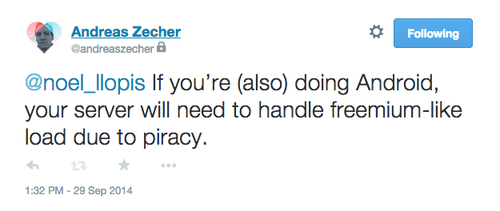Trending
Opinion: How will Project 2025 impact game developers?
The Heritage Foundation's manifesto for the possible next administration could do great harm to many, including large portions of the game development community.

Featured Blog | This community-written post highlights the best of what the game industry has to offer. Read more like it on the Game Developer Blogs or learn how to Submit Your Own Blog Post
How do you make a living from a week-long multi-player-only game that requires players to be interested in both a diplomacy and a strategy? We're not sure yet, but here's how our thinking has evolved over the last 2 years.

How do you make a living from a week-long multi-player-only game that requires players to be interested in both a diplomacy and a strategy? This is a question we’ve been asking ourselves since very early in development, and are still changing our minds on every few months.
In this post I’d like to describe how our thinking around this question has changed over the last two years. I’d also love to hear what you think about these different approaches. If you’d like to share your thoughts or ask a question, please do so via comments below.
1. The Premium Model

This is the first and simplest model we considered. It’s also the one we’ve circled back around to for now, but who knows if it will be the final one. We’ll get to that later.
In this model, the only question is what the price point is. Subterfuge being a niche game, we expect it to (a) not sell a ton of copies, and (b) have an audience that is not nearly as price sensitive as the typical mobile players. So a higher price point seems to make sense both in that we think players will be willing to pay it and that we need to charge more than 99c per player in order to make a sustainable living from a niche game.
We’re currently thinking it would cost somewhere in the $5 - $10 range, but again, we change our minds on a fairly regular basis :)
We had one big fear about the premium model: Subterfuge is a multiplayer only game, and growing a community of players will heavily rely on players inviting their friends to play with them.
It’s much easier to get a friend to join a game if it’s free. If we charge too much (or even if we charge at all) would we be effectively choking the game and preventing it from taking off? Yeah, we’d make more money per copy sold, but that doesn’t matter if nobody’s able to get enough friends to pay with them. Note that at this point we were still thinking that most games would be played with a group of friends rather than strangers, which is an assumption we later realized was incorrect.
2. The League of Legends Model (F2P)

So we thought, let’s make the game free to play, and sell new ways to experience the game rather than powerups, hats, or other things that cheapen the experience. This pearl of wisdom came from Al Reed of Demiurge Studios, who has been a wonderful advisor and sounding board when it comes to discussing business models. Thanks Al!
League of Legends is one of the most successful F2P games out there, and they sell heroes, so we can sell specialists, and that should work, right? Well, not really, for several reasons. The main one is that from what I’ve heard, League of Legends is not nearly as profitable on a per-player basis as other F2P games. They owe their success to an unfathomable number of players they have drawn in thanks to mass appeal, expert marketing, and like all big successes, some luck. Subterfuge is not a mass appeal game, and neither Noel nor I have the required marketing knowhow or the desire to learn it. That leaves only luck, and if we wanted to play that game we’d be buying lottery tickets for a dollar, not putting 3 years of our lives into making a game.
There’s another thing about the F2P model that wouldn’t work well for Subterfuge. If the game is free, a lot more people will just “give it a shot”. With Subterfuge being a very slow game and having a non-trivial learning curve, it’s really not for everybody. Having too many players “give it a shot” will result in a high drop out rate among first time players, and that will have a negative impact on every player’s experience. We’ve found that a 6+ player game can tolerate one player dropping out, but if two or more drop out, it can create heavy imbalances.
But probably the biggest reason we didn’t want to go the F2P route is that anyone who launches a F2P game is effectively committing to an ongoing project that involves creating more content over time, dealing with metrics, DAU, ARPU, etc. These are things Noel and I have zero interest in. We want to make a game, release it, and go work on something new, unshackled.
3. The Board Game Model

So we backtracked and asked ourselves: how else can we get players to easily recruit their friends? Since we’d been thinking of Subterfuge as rooted in board games, and expect to have the kind of audience that plays board games, maybe we can sell it like a board game?
I would buy the game for a relatively high price and then all my friends would play for free, as long as they play with me. Board game players are used to paying $30 - $50 for a box so maybe $20 - $30 would not be so out of the question even on mobile?
The physical board game model also uses expansions, which could lend themselves well to IAP in Subterfuge, so bonus.
By inviting your friends to play with you, there’s a social contract there that would reduce the likelihood of players dropping out. You don’t just get up and go when you’re playing a board game with your friends. First, it’s impolite, second, you enjoy interacting with your friends even if you’re not super into the game.
And then we started to have some doubts. Our alpha testing showed that the majority of games are played with random players rather than friends specifically invited (anyone in the alpha has the ability to invite whoever they want into the alpha). If we rely on players who buy the game to start public games for other players to join, there’s no guarantee that the supply of public games will match the demand for them, and that could make for a fatally negative first impression for new players. Imagine downloading a game and having to wait days for a chance to play.
4. The Pay or Recruit Model

Ok, so we can fix this! We use the League of Legends Model, but only let paying players start and join public game. We let everyone (paying and non-paying players) start private games, which require you to invite your friends.
This solves both problems:
a. Paying players can quickly create and join public games and play with other committed (paying) players who are much less likely to drop out.
b. Anyone can play the game for free, but if you’re not paying, you can only play a private game by inviting your friends to play with you and the social contract would discourage dropouts. And who knows, maybe your friends will end up paying down the line.
As we started to explore this model more deeply, we realized we’d opened a Pandora’s box of design issues. Example: players are most likely to buy stuff mid-game, so how do you sell specialists to players mid-game in a way that is intuitive, doesn’t break determinism, and doesn’t make Subterfuge feel like a pay-to-win game?
We had many long conversations about the implementation details of F2P in Subterfuge and the more we talked about it, the more we caught ourselves saying things that didn’t jive with our game design ideals. We want to treat players generously, respectfully, and honestly, and every idea we explored felt like it would be either ineffective, or not meet our above criteria. What they all had in common though, is that they’d complicate the design and implementation in very significant ways without actually making the game any better.
At that point we started thinking that we should go back to the Premium Game Model for the following reason: we have no idea if an F2P Model will generate more or less revenue than the Premium Model, so LET’S OPTIMIZE FOR PLAYER EXPERIENCE RATHER THAN WHAT WE THINK WILL MAKE MORE MONEY.
Optimizing for player experience clearly meant just charging for the game up front, fostering a high quality, committed community of players, and letting them enjoy the game together. We felt really good about that, until this happened:

Normally we don’t care about so-called piracy, but in this case our server infrastructure would have to support them, and we would eat that cost. It’s already a little scary selling a premium game and committing to providing back end infrastructure forever. it’s another matter committing to providing back end infrastructure forever for a much larger audience that hasn’t paid at all.
5. The Anti-Piracy Model

So we came up with this idea: Subterfuge will be free to download and include some kind of single player experience that teaches you how to play. But if you want to actually play, you’d have to buy the game using IAP. This is effectively the Premium Model, but executed via IAP rather than up-front purchase.
This will allow us to associate the purchase with your account, so the server can lock out the players that didn’t pay for the game — problem solved! Yay!
Well, kinda…
The problem with this model is that by making an app available for free you set certain expectations. You’re much more likely to piss off a player if you offer them a free app and then say ��“sorry, you have to pay to really play!” than if you simply offer them a paid app and let them make an informed decision up front.
And then we asked ourselves how many non-paying players do we actually expect to see, and how much that would actually cost us in server infrastructure?
Would it really cost so much to support that player base that we’re willing to invest the extra development time to prevent it, and by doing so potentially compromising the player experience for EVERYONE who downloads the game? That’s the DRM trap all over again.
If we were making a mass appeal game and our server infrastructure were expensive, this would not be an easy question. Subterfuge is a niche game though, and our backend is incredibly lightweight, so our answer was no, let’s assume it’s not worth it. If the worst case scenario really comes to be, and we end up with a massive audience of non-paying players and not enough paying players to pay the bills, then we could try to Monetize That Shit ™.
And so, we looped back around to the Premium Model again.

I’m going to conclude this post with another pearl of wisdom imparted upon me by Al Reed. One that makes me feel really good about the Premium Model. With F2P/IAP, at some point you have to try to get the player to pay, and you do that by presenting them with a value proposition: You give me money and I give you something else in return. I’m told this is a very difficult thing to do well, and it’s both art and science.
An invitation from a friend to come play a game with them for a week, even if it costs $10, is an excellent value proposition for anyone who can afford to pay for a game. Al pointed out that It would be extremely difficult (if not impossible) to present a more compelling value proposition to the player once they’re already in the game. We tried to think of one, but we weren’t able to. So for now, it’s the premium model, but let’s see if that lasts.
Again, if you have any thoughts or questions, let us know via comments below.
Subterfuge is currently in private alpha (iOS only) and if you’d like to try it out, you can sign up at http://subterfuge-game.com. We expect to release it in the summer of 2015 on iOS and Android.
Read more about:
Featured BlogsYou May Also Like